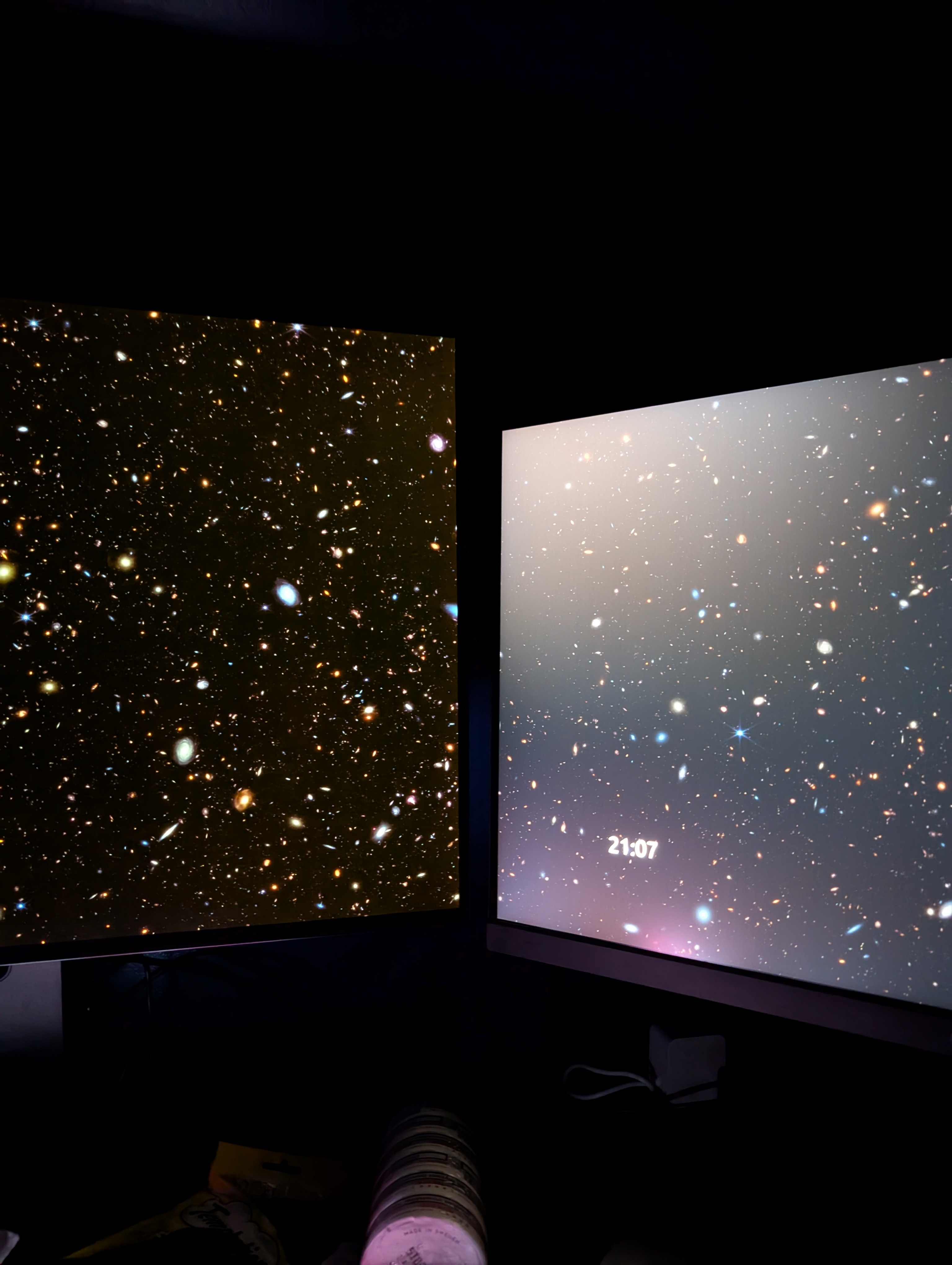
My WOLED monitor vs my old main.
It’s amazing. With my black theme, a black background, and the mouse off the monitor, you can’t even tell the thing is on.
It’s amazing. With my black theme, a black background, and the mouse off the monitor, you can’t even tell the thing is on.
I have a solid black color as background and a hidden task bar on my OLED monitor.
It’s just a mouse cursor floating in nothingness.
I just don’t understand why I find it so cool that the only lights that are on are the lights giving you information.
I’m glad there are other people like you stop and appreciate it!
Goddamn, you just sold me.
Be careful though, with the contrast between my old ips and my new monitor, all it took was a best buy gift card bonus for Christmas for me to justify an open box return for a second one.
It does matter, but there are drawbacks and advantages each way.
My current monitor is LCD. When I bought it, that was because OLED prices were significantly higher.
I like the look of the inky blacks on OLEDs. I really love using the things in the dark.
If you’re using a portable device, OLED can save a fair bit of power if you tend to have darker pixels on the screen, since OLED power consumption varies more-significantly based on what’s onscreen. I use dark mode interfaces, so I’m generally better-off from a pure power consumption standpoint with OLED.
https://en.wikipedia.org/wiki/Comparison_of_CRT,_LCD,_plasma,_and_OLED_displays
OLED displays use 40% of the power of an LCD displaying an image that is primarily black as they lack the need for a backlight,[35] while OLED can use more than three times as much power to display a mostly white image compared to an LCD.
OLEDs are more prone to burn-in than LCDs, but my understanding is that newer OLEDs have significantly improved on this. And it takes a long time for that to happen.
Aside from price, I’d mostly come down on the side of OLED. However, there is one significant issue that I was not aware of at the time I was picking a monitor that I think people should be aware of. As far as I can tell from what I’ve read, present-day OLED displays have controllers that don’t deal well with VRR (variable refresh rate, like Freesync or Gsync). That is, if you’re using VRR on your OLED monitor and the frame rate is shifting around, you will see some level of brightness fluctuation. For people who don’t make use of VRR, that may not matter. I don’t really care about VRR in video games, but I do care about it to get precise frame timings when watching movies, so I’d rather, all else held equal, have a monitor that doesn’t have VRR issues, since I have VRR enabled. If I didn’t care about that, I’d probably just turn VRR off and not worry about it.
EDIT:
https://www.displayninja.com/what-is-vrr-brightness-flickering/
This was a great comment! Where does QLED fit into all of this?
I’ve never really wanted to get a QLED monitor, so I haven’t spent time looking at their VRR behavior; sorry. I imagine that there’s material out there about it, though.
No brightness issues here with LG QLED.
There’s of course the limitations of VRR itself and the implementation. Freesync only works within a frame rate range.
I’ve seen strobe/flicker when it’s too low.
I cap my GPU to 108FPS to prevent tearing, I leave VRR always on.
It does matter. But all my big displays are still LCD, because of cost.
It’s about blackpoint. With an LED, pixels which are black still have a backlight. This makes them a kind of grey.
With OLED, the pixels themselves emit light. This means that black pixels are unlit.
The difference is obvious in a dimly lit room looking at dark content.
That said, while I would love OLEDs all around, they’re expensive. I’m willing to give up having true blacks for the cost difference. It may be different as costs on OLED come down.
I do have an OLED phone, because Samsung is pumping out OLEDs on everything.
OLED also matters more on phones because such a large fraction of their power use goes to the display (apparently up to 80% at max brightness on a task that doesn’t require much computing power). A desktop would need one hell of a multi-monitor setup to get remotely close, plus you aren’t as concerned about power usage when there’s no battery to deplete.
It does matter, but does is it justify spending 50% more on a product? You’d only notice the difference if you did side-by-side testing anyway. Ignorance truly is bliss.
I said it matters: “the difference is obvious”.
But for me, it does not justify the cost difference at the current time.
You definitely can easily tell led from oled. No need for a side by side test.
Reposting from my comment in the past. TLDR: I took the plunge on OLED TV in 2021 as a primary monitor and it’s been incredible
I’ve been using an LG C1 48" OLED TV as my sole monitor for my full-time job, my photography, and gaming since the start of 2021. I think it’s at around
30004500 hours of screen time. It averages over 10 hours of on time per weekdayIt typically stays around 40 brightness because that’s all I need, being fairly close to my face the size. All of the burn-in protection features are on (auto dimming , burn-in protection, pixel rotation) but I have Windows set to never sleep for work reasons.
Burn in has not been a thing. Sometimes, I leave it on with a spreadsheet open or a photo being edited overnight because I’m dumb. High brightness and high contrast areas might leave a spot visible in certain greys but by then, the TV will ask me to “refresh pixels” and it’ll be gone when I next turn the TV on. The task bar has not burned in.
Experience for work, reading, dev: 8/10
Pros: screen real estate. One 48" monitor is roughly four 1080p 22" monitors tiled.The ergonomics are great. Text readability is very good especially in dark mode.
cons: sharing my full screen is annoying to others because it’s so big. Video camera has to be placed a bit higher than ideal so I’m at a slightly too high angle for video conferences.
This is categorically a better working monitor than my previous cheap dual 4k setup but text sharpness is not as good as a high end LCD with retina-like density because 1) the density and 2) the subpixel configuration on OLED is not as good for text rendering. This has never been an issue for my working life.
Experience with photo and video editing: 10/10
Outside of dedicated professional monitors which are extremely expensive, there is no better option for color reproduction and contrast. From what I’ve seen in the consumer sector, maybe Apple monitors are at this level but the price is 4 or 5x.
Gaming: 10/10
2160p120hz HDR with 3ms lag, perfect contrast and extremely good color reproduction.
FPSs feel really good. Anything dark/horror pops A lot of real estate for RTSs Maybe flight sim would have benefited from dusk monitor setup?
I’ve never had anything but a good gaming experience. I did have a 144hz monitor before and going to 120 IS marginally noticable for me but I don’t think it’s detrimental at the level I play (suck)
Reviewers had mentioned that it’s good for consoles too though I never bothered
Movies and TV: 10/10 4K HDR is better than theaters’ picture quality in a dark room. Everything I’ve thrown on it has been great.
Final notes/recommendations This is my third LG OLED and I’ve seen the picture quality dramatically increase over the years. Burn-in used to be a real issue and grays were trashed on my first OLED after about 1000 hours.
Unfortunately, I have to turn the TV on from the remote every time. It does automatically turn off from no signal after the computers screen sleep timer, which is a good feature. There are open source programs which get around this. Bazzite and Mac seems to handle this too.This TV has never been connected to the Internet… I’ve learned my lesson with previous LG TVs. They spy, they get ads, they have horrendous privacy policies, and they have updates which kill performance or features… Just don’t. Get a streaming box.
You need space for it, width and depth wise. The price is high (
around 1k USD on saleprices are even lower now) but not compared with gaming monitors and especially compared with 2 gaming monitors.Pixel rotation is noticeable when the entire screen shifts over a pixel two. It also will mess with you if you have reference pixels at the edge of the screen. This can be turned off.
Burn in protection is also noticable on mostly static images. I wiggle my window if it gets in my way. This can also be turned off.
You can block all the ads/spying with pihole. And only let the streaming apps through. Then you can still use the native apps but also have zero ads.
I really want to try pihole or Adguard
I don’t have experience with adguard but I’ve been using pihole for years. I’d never want to have a home network without one.
I’ve had a mid-tier OLED tv the last few months. The colors and contrast look phenomenal to me. You get true black on OLED since each pixel is individually lit.
I watch a lot of horror films which will have many dimly lit or night time scenes. OLED makes those scenes much easier to see because of increased contrast between dark and light.
Oleds look great, but I’m severely allergic to the concept of burn in. Not interested in technology that has such a comparatively short life span, and don’t want to think about auto hiding UI elements either.
Modern ones have anti-burn in stuff so when it detects fixed elements it turns these down in intensity. For what it’s worth mine is going on 4 years regularly playing a game with fixed UI and no issues so far touches wood.
deleted by creator
I like to read in the dark, and a black OLED screen with white text is so much more comfortable than even an e-ink screen for me.
LCDs are good for price, I guess. All my big monitors are LCD, but phone has to be OLED.
I noticed that every Samsung phone is now OLED (branded as “AMOLED”), even the lowest of the budget A series.
Probably cheaper to just do Oled for the mobile line up vs split manufacturing.
The strange nature of mass producing parts…
I have an LG OLED from ~2016 or so. Burnt, especially green. I kept it pretty even for wear, until I uh…I was playing Mario 64 ROM hacks, went to sev for a Slurpee and forgot to turn the TV off. Luigi’s hat burnt into the screen in his sleeping idle animation and that was that. Took less than half an hour at that point, the panel was already worn out by then for that to happen. Now it’s the workout room TV. Yeah it was very pretty, especially useful for 4K CRT Royale retro shaders. Not worth the price unless you got ample cash to burn as I consider these panels disposable.
I went with LCD again after that. MicroLED 75" with local dimming. It’s fine, good enough. You see the dimming zones while web browsing text heavy dark themed websites like this one, but it’s not a deal breaker for me.
Personally I wouldn’t buy another until local dimming zones are way way more numerous and smaller on cheaper models. 1000 nits is enough, uncomfortablly bright sometimes now with HDR on. 120hz VRR is great, don’t need more. Don’t care about 8K. Or I guess if OLED became impossible to burn, or take so long I wouldn’t care. At least a decade, without having to mitigate the issue by hiding task bars or using lower brightness etc.
I don’t want to worry about it.
Even the most subtle burn in bothers me, but grey instead of black doesn’t. LED is better than OLED for me.
As soon as there is a technology with the same colours as OLED with absolutely no burn in (and my existing displays get too old), I’ll consider it.
OLED every time. The original PS Vita was far superior to the remake with the LCD, and the OLED Steam Deck is way better than the first model. Also the Switch OLED screen is very nice, but the Switch is garbage in general so screw it.
Bought a highly rated QLED a year ago
Already getting dark spots on the screen
Getting an OLED next time
I think you answered a question I had: whether QLED or OLED came out first. I presume it’s in that order based on the issue you mention.
quality: OLED wins by every conceivable metric
price: OLED is significantly more expensive but worth it (assuming you can afford it)
longevity: burn-in makes OLED worse but still (if you can afford it) reasonable.
My eye site is bad enough that I can’t tell the difference.
OLED for my tv has been awesome, thinking I will go laser projector next though











